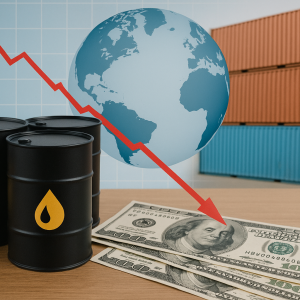Italy: services less driven in Q3, industry less weak, exports still bad
Friday 13 September 2024
Share on
GDP grows. After the +0.2% recorded by Italian GDP in Q2 2024 (+0.3% in Q1), with exports losing share, indications for Q3 are of lower growth in services and a softening in the decline of industry. Inflation is slowing in the Eurozone and households and businesses will finally be helped by the rate cut, which stimulates consumption and investments. However, the price of gas is rising in Europe.
Falling rates. The ECB, which had cut rates in June (by -0.25%), decided on a second rate cut (again -0.25%) on 12 September. Markets expect a first FED move on the 18th, also limited (-0.25%), but followed by further cuts before the end of the year. In the Eurozone, sovereign rates were also on a downward path: BTP at 3.58%, from 3.92% in June, Bund at 2.22% from 2.49%.
Inflation almost in line. In the Eurozone, inflation fell to +2.2% in August (+2.6% in July), close to the ECB threshold, although net of energy and food it is at +2.8%. Italy remained the country with the lowest inflation: +1.1% (core at +2.1%), versus +2.0% in Germany, +2.2% in France, and +2.4% in Spain. In the US, the latest data were also favourable: +2.9% in July (from +3.5% in March), but core still high (+3.2%).
Energy: gas price rises. After the jump in August (+17.2%), the price of gas in Europe remained at €36/mwh in September, from a low of €27 in March. Oil prices, on the other hand, fell to $74 per barrel, from a high of $90 in April. Both prices are higher than 2019 levels. More expensive gas will raise electricity prices for households and businesses, negatively affecting inflation.
Services slow down. In Q2, services had grown (+0.4% added value), driven by tourism (+2.7% year-on-year in June spending by foreigners). In July, RTT (CSC-TeamSystem) indicated a recovery in turnover after June's decline. However, in August, the PMI dropped again and now indicates more tenuous growth (51.4 from 51.7) and only partly recovers business confidence after months of decline.
Industry: smaller decline. Production, after two months of recovery, decreased by -0.9% in July, leading to a negative gain in Q3 as well (-0.4%, from -0.9% in Q2). The outlook is less weak: RTT reports a rebound in industrial turnover in July, in August the HCOB PMI almost recovered (49.4, from 47.4), but business confidence lost further ground.
I ease consumption. Household spending in Q2 (+0.2%) continued its slow positive momentum. Modest outlook: real income is supported by price restraint, moderate wage growth and rising employment, the propensity to save has returned to historical values, the cost of credit is falling, but household confidence fell in August after three increases.
The investment dynamic is still positive. In Q2 they grew by +0.3% (from +0.4% in Q1). Plant and machinery (+1.1%) performed well, driven by transport equipment (+1.7%). Construction, on the other hand, remained static: the decline in residential buildings (-1.1%), due to the disappearance of the Superbonus, was offset by the increase in non-residential buildings (+1.8%), supported by the NRP.
On the employed, not the labour force. The good performance of the Italian labour market continues: employment is still up (in July +56,000, +260,000 over January) and unemployment is down (-107,000 job seekers; at 6.5% the rate, the lowest since March 2008). However, since the beginning of 2024 inactive persons have stopped falling and the labour force has stopped expanding, with the risk that employment growth may be limited in the near future on the supply side.
Falling exports. Italian exports decreased in Q2 (-1.8% goods, -0.3% services; in volume), although at levels well above pre-Covid (+7.1% goods, +18.4% services). The decline is spread across EU (-2.1%) and non-EU markets (-0.8%); sales in Germany and major Asian countries in particular are down. Data on foreign manufacturing orders (Istat and PMI) also gave negative indications for the summer months: the weakness of European demand weighed heavily. World trade in goods, on the other hand, picked up in the 2nd, supported by Chinese trade; however, the PMI on global manufacturing orders returned to recessionary territory in the summer.
Weak Eurozone. In Q2, the area's GDP grew by +0.2% (+0.3% in Q1) thanks to the contribution of public spending, but above all to net foreign demand (+0.5%), which offset the drop in investment (-0.5%), while household spending fell slightly. The area is driven by Spain (+0.8%), Italy and France (+0.2%) are holding up, while Germany is in the negative (-0.1%).
China: lights and shadows. Exports accelerated more than expected (+8.7% annualised in August): Chinese companies may have adopted strategies to anticipate the intensification of tariff barriers. On the other hand, imports remained stagnant (+0.5%): in addition to the competitiveness of local companies, this is explained by weak domestic demand. Retail sales grew in July (+2.7% per year), but this result was inflated by a positive 'base effect' compared to last year, which was weak compared to pre-Covid levels.
Is the US really at risk of recession?
Asian markets collapsed in the summer. Asian stock exchanges slumped on 5 August: in particular, Tokyo suffered a -12.4% in one day. This slide, due to the July increase in Japanese official rates and the subsequent sharp reduction in the carry trade phenomenon (borrowing in Yen at low rates to invest in Dollars at high rates), which created volatility, was linked in the media to fears of a recession in the US. The declines in Europe and the US were much smaller (-2.2%).
Why has the collapse in Japan been associated with a US recession? There have long been fears of a possible turnaround in the US economy, but it has always surprised on the upside. As recently as June, the FED had confirmed its forecast of good economic growth in the US (+2.1% GDP in 2024, +2.0% in 2025), despite the fact that it was predicting a slow downward path for its rates (which are currently in the 5.25-5.50% range). But then, just as the Tokyo stock market collapsed in late July/early August, some rather weak US economic data was released, which seemed to be 'proof' of those latent fears. And the stock market declines seemed to be the 'counter-evidence'.
Which US data have spooked the markets? At the end of July, the Chicago Purchasing Managers' Index fell to 45.3 points from 47.3 and the manufacturing PMI to 49.6 from 51.6 on 1 August, although both fell less than traders expected (44.8 and 49.5). The figure that shook traders' confidence was the ISM manufacturing, also published on Thursday 1 August: it was confirmed at a recessionary level (46.8 points), down sharply from June (48.5) and above all much lower than expectations, which were even for a slight recovery (48.8). The following day, Friday 2 August, the change in jobs in the non-agricultural sectors (one of the most closely monitored indicators on the US economy) was an unfavourable surprise, or rather less favourable than market operators thought: 114 thousand units, down from 179 thousand in June, and much lower than the 176 thousand expected. At the same time, the unemployment rate increased to 4.3% (from 4.1% in June and against expected stability).
Subsequent data on the US dampened the tension. Macro indicators published in the following weeks provided encouraging indications on the services side, still of slowdown in the labour market, disappointing on the manufacturing side. In August, the non-manufacturing ISM (51.5 points, up from 48.8 in June) and the services PMI (55.7 from 55.3) confirmed an expansionary indication. And consumer confidence rose (103.3 points from 101.9). Weekly claims for unemployment benefits were lower than expected, but the disappointing change in employment in the non-farm sectors (+142 thousand) confirmed the slowdown in the labour market. On the other hand, industrial production contracted in June by 0.6%, while economic indicators on August activity were recessive.
So, is the US economy at risk of a recession? US GDP in Q2 grew more than expected (+0.75%), thanks to a good contribution from consumption (+0.5%) and the albeit slower growth in investment (+0.13%). The performance of the US economy at this stage therefore depends, above all, on the resilience of consumption and the possible recovery of investments. The former, however, are showing some signs of tension: 1) the savings rate has reached an all-time low (2.9%) and is expected to rise again; 2) credit card defaults and consumer credit have increased; 3) retail sales are growing more than real wages; 4) if the slowdown in the labour market is confirmed, wages would be affected. On the other hand, the weakness of manufacturing and investment activity, especially in the construction sector, depends on high rates. After the recent stock market fears, traders (CME data) expect FED interest rates to be cut in September and again by December to 4.25-4.50: a half-point lower end point than they expected in the first part of July. The markets' view seems to be that the Fed will have to cut more, to support a US economy judged to be in trouble, poised between a soft landing (which seems the most likely scenario, based on current data) and a stagnation/mild recession.






















